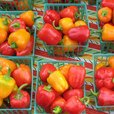More Americans are cooking and eating meals at home and fresh, locally produced foods are becoming more popular, according to a list of 2007's top 10 food trends in the current issue of Food Technology magazine. It’s about time, right?
Among the trends:
Economic pressures are among the factors pushing Americans to prepare and eat more meals at home.
Word-of-mouth is a key factor in the success of new food products and celebrity chefs are encouraging more adventuresome cooking.
Reducing the number of steps in food preparation is a major way to increase sales of food products.
Texture, crispness and crunch are important.
Products free of undesirable ingredients are viewed favorably by consumers.
Fresh is the most desirable attribute in food and foods marketed as local, seasonal, hand-made, and natural are increasingly popular.
Food purchases are greatly influenced by shoppers' desire to lower their risk of developing health problems.
Trend 1: Home dinners – Dinner time at home is the new trend, seventy five percent of the people who were polled preferred to eat “in” as they believed in healthier eating and that’s good news for those who are concerned about the growing obesity problem.
Trend no 2: Food is entertainment - Demand for famous chefs is on a high as food channels compete to get them on their shows. Learning exotic cuisine and the art of food presentation makes it to the must-do list of food lovers.
Trend no 3: Convenient food products– People are getting busier by the day and convenience is what they are looking for when they buy food products. Fresh, ready-to-eat salads, precut veggies, pouches of tuna, skillet meals, single servings and 100-calorie packets are gaining popularity.
Trend no 4: Feel good foods – Aroma, crunchy, crispy, fresh- these are the words that’ll get attention when people buy food. Fresh herbs, floral scents like lavender and jasmine adds excitement on the menu.
Trend no 5: Kids diet – parents are getting concerned about the growing obesity among children and new tasty and healthy snacks and food products are being created especially for them.
Trend no 6 : Free is the word - Trans free, gluten free, caffeine free, no added sugar, no artificial sweeteners, reduced sodium – the market for these products is accelerating as more people go on diet to reduce weight.
Trend no 7: Eating local – Organic, fresh and seasonal food gains popularity as the number of green foodies increase. “Foodmiles’ is the watch word among green foodies and locally grown produce is a hit among them.
Trend no 8: Medical conditions – Food purchasing will be made on the advice from health specialists; fruits, veggies and fortified products get top priority.
Trend no 9 : Exotic- is the word that every one loves; innovative beverages, organic energy drinks were the top gainers in the U.S food market last year.
Trend no 10: Snacks – the market for snacks sees the highest growth as snacking in-between increases with the increase in entertainment and television viewing times.
So, that’s the list and what’s your favorite food trend among these?
SIMPLE: Eating Local...supports our farmers and producers!!!
Locally Grown Foods
As people seek fresher foods, they have begun to connect with local family farms. Community-supported agriculture (CSA) programs and farmers' markets give consumers direct access to produce, meats, cheeses, breads, honey, and other foods that are produced in nearby communities. In the past 10 years, the number of local farmers' markets has more than doubled -- it is up from 1,755 to 3,706, according to the U.S. Department of Agriculture's Agricultural Marketing Service.
Why it's here to stay: Because they are so fresh, locally grown fruits and vegetables often have a nutritional edge over produce raised on "factory" farms. The latter, which constitutes most of the produce grown in the United States, is picked about four to seven days before it arrives on supermarket shelves, and shipped for an average of 1,500 miles before it's sold, according to Local Harvest, a nonprofit agricultural research group. All that downtime takes a toll. USDA researchers have found that if it's not handled properly, produce can lose up to half its nutrients in transit. Water-soluble nutrients such as vitamin C are particularly vulnerable.
What it means for you: "Buying food from local vendors gives you input," says Gail Feenstra, R.D., food systems analyst at the University of California at Davis' Sustainable Agriculture Research and Education Program. "You can find out how things were grown. You can also request varieties of fruits and vegetables that wouldn't be available elsewhere." And then there's the most important reason of all: Because of its freshness, locally grown food tastes better than produce designed to be shipped. "Growers' priority is on taste and texture versus transportation," Feenstra says.
November 15, 2007
Food Trends for 2007
Posted by
Lane
at
11/15/2007
![]()
Labels: Farmers' Markets, Take a look, Tips You can Use
Subscribe to:
Post Comments (Atom)









1 comment:
I love farmers' markets:)
I tagged you for a MeMe!
Post a Comment